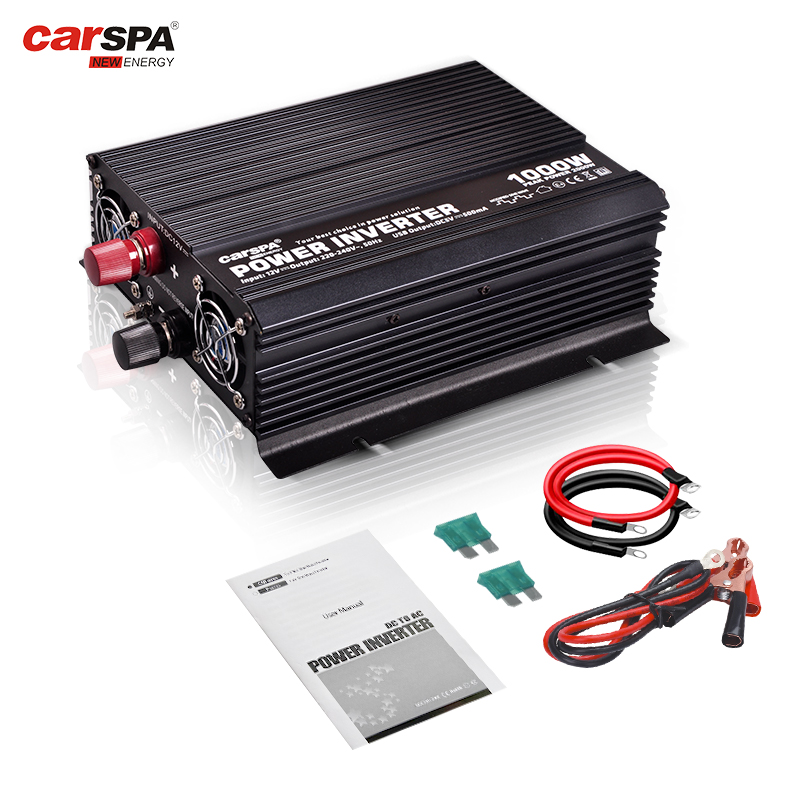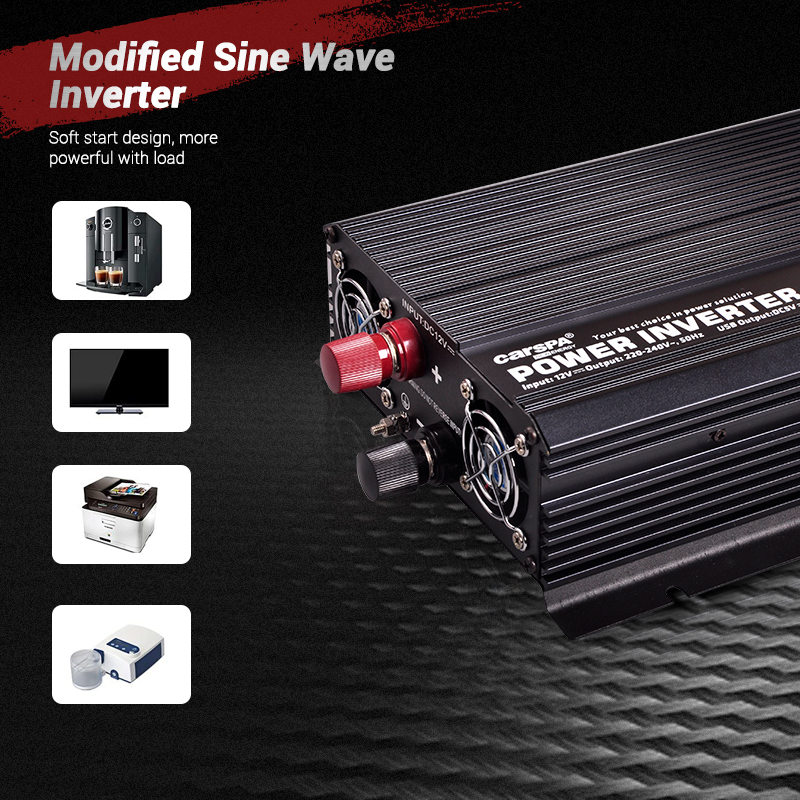Can a 1000W inverter run a fridge or a coffee machine?
Inverters are an important component of off-grid power systems, especially in travel, camping and backup power applications. They can convert direct current (DC) from batteries into alternating current (AC) required by household appliances. For common household appliances such as refrigerators and coffee machines, many people wonder whether a 1000W power inverter is enough to drive these devices. This article will answer this question in detail and discuss it from the aspects of power requirements, starting current, and actual application scenarios.
1. What is the power requirement of a refrigerator? Can a 1000W power inverter drive a refrigerator?
Refrigerators are one of the common electrical appliances in every household, and their power requirements vary with different models and types. Understanding the power requirements of refrigerators is the key to determining whether a 1000W inverter can drive a refrigerator.
Operating power of refrigerators
The power of refrigerators is usually divided into two parts: starting power and operating power. Operating power is the power required by the refrigerator in a stable working state, which is generally low. For example, the operating power of a typical household refrigerator is usually between 100W and 300W, depending on the size and model of the refrigerator.
Assuming that the operating power of a household refrigerator is 150W, according to the formula:
Running time = inverter power/refrigerator operating power
If a 1000W power inverter is used, it can easily drive the normal operation of the refrigerator.
Starting power of refrigerator
However, the starting power of a refrigerator is much higher than the running power. The starting power is the instantaneous power required when the refrigerator compressor starts, which may be 3 to 7 times the running power. For example, if the operating power of a refrigerator is 150W, the starting power may be as high as 450W to 1050W. The peak of the starting power may exceed the tolerance range of the 1000-watt power inverter for a short time, causing the inverter to overload.
To deal with this problem, users should choose inverters with "peak power" or "instantaneous power" functions. These inverters can handle current peaks higher than their rated power for a short time. For example, if the peak power of the inverter is 2000W, it can support higher power requirements at the moment when the refrigerator starts.
Influence of inverter efficiency
Inverters are not 100% efficient in converting DC to AC. Most inverters have an efficiency between 85% and 90%, which means that some energy is lost as heat during the conversion process. Therefore, the actual available power is slightly lower than the rated value. Assuming that the efficiency of a 1000W power inverter is 90%, the actual available power is:
Available power = 1000W × 0.90 = 900W
This means that some energy is lost during the power conversion process, so when choosing an inverter, the efficiency of the inverter should be taken into consideration.
Analysis of actual application scenarios
In daily life, if you just want to use the refrigerator occasionally during camping or RV travel, a 1000W power inverter can fully meet the needs, but you must ensure that the refrigerator's startup power is within the inverter's peak range. At the same time, choosing an inverter with high peak power and overload protection can effectively cope with the instantaneous power demand when the refrigerator starts.
2. What is the power demand of the coffee machine? Can a 1000W power inverter drive a coffee machine?
A coffee machine is an everyday household appliance that is often used to make coffee quickly. The power requirements of a coffee machine are different from those of a refrigerator because its power mainly depends on the working state of the heating element. We will discuss in detail the power requirements of a coffee machine and whether a 1000W power inverter is suitable for driving it.
Power range of coffee machines
The power range of coffee machines varies depending on the model and function. Common drip coffee machines usually have a power range of 600W to 1200W, while more complex espresso machines may require higher power, generally between 1000W and 1500W.
Assuming that the power of an ordinary drip coffee machine is 800W, a 1000W power inverter can provide enough power to drive such a coffee machine. However, if the power of the coffee machine is close to the rated power of the inverter (such as a 1200W coffee machine), the 1000W power inverter may not operate stably.
Power requirements at startup
Similar to refrigerators, coffee machines also generate instantaneous power peaks when heating. Especially when heating water or starting the hot plate, the power demand of the coffee machine may exceed its normal operating power for a short period of time. If the inverter cannot handle these instantaneous power peaks, it may trigger the inverter's overload protection, causing the coffee machine to fail to start normally.
For example, if an 800W coffee machine has an instantaneous power increase to 1200W when heating, a 1000 watt power inverter may stop running due to insufficient power. Therefore, it is recommended to choose an inverter with a peak power of 2000W or higher to cope with the power demand when the coffee machine starts.
Compatibility of inverter and coffee machine
In order to ensure that the inverter can drive the coffee machine smoothly, in addition to considering the power, it is also necessary to check whether the inverter has a stable voltage output and waveform. Some coffee machines have high requirements for the waveform of the power supply, especially some high-end espresso machines, which may require a pure sine wave inverter to provide smooth power output. If a lower-end modified sine wave inverter is used, the coffee machine may not work properly or may be at risk of damage.
3. How to choose an inverter suitable for refrigerators and coffee machines?
When choosing an inverter, power is one of the most important considerations. However, considering power alone is not enough, and there are many other factors to consider to ensure that the inverter can smoothly drive devices such as refrigerators and coffee machines.
The difference between peak power and continuous power
When purchasing an inverter, you will find that most inverters are marked with two power values: continuous power and peak power. Continuous power is the power that the inverter can stably provide in long-term operation, while peak power is the maximum power that the inverter can withstand in a short period of time.
For example, an inverter labeled "1000W continuous power, 2000W peak power" can withstand up to 2000W of instantaneous power when starting the device, but can only provide 1000W of continuous power for a long time. Therefore, when the starting power of the device is higher than 1000W but lower than 2000W, the inverter can still work stably.
Waveform Type Selection
There are two main types of inverter output waveforms: modified sine wave and pure sine wave. Modified sine wave inverters are relatively cheap, but their output current waveform is not perfect, which is suitable for some simple home appliances. Pure sine wave inverters have an output that is consistent with the mains, which is suitable for driving devices that require high power quality, such as high-end coffee machines and refrigerators.
Therefore, if you need to run a refrigerator and a coffee machine at the same time, it is recommended to choose a pure sine wave inverter to ensure the normal operation of the equipment and avoid damage.
Consider battery capacity and efficiency
To drive a 1000W power inverter, you also need a large enough battery to provide continuous power output. Assuming you use a 12V 100Ah battery, its total energy is:
Total energy = 12V×100Ah=1200Wh
If the inverter efficiency is 90%, the actual available energy is:
Available energy = 1200Wh×0.90=1080Wh
Assuming the inverter continuously outputs 1000W, the battery can support the inverter operation for about 1 hour. Therefore, if you need to drive the refrigerator and coffee machine for a long time, you need to equip a larger capacity battery or connect multiple batteries in parallel.
4. Analysis of other practical application scenarios of inverters
In addition to driving refrigerators and coffee machines, 1000W car inverters can also power other household appliances and electronic devices. In practical applications, choosing a suitable inverter can greatly improve the efficiency of power use, especially in camping, RV travel or emergency situations.
Power management in RVs
For people who like RV travel, inverters are indispensable equipment. A 1000W RV inverter can power a small refrigerator, coffee machine, lighting equipment, mobile phone charger and laptop in the RV to ensure power needs during the trip. However, if the RV is equipped with multiple high-power devices (such as microwave ovens, air conditioners, etc.), a larger power inverter, such as 2000W or 3000W, may be required.
Emergency backup power
Inverters can serve as a backup power system for the home when the power grid is out, ensuring the continued operation of refrigerators, lamps, mobile phone chargers and other key devices. Using a battery and inverter combination with the right capacity can cope with short-term power outages, especially after natural disasters or accidents, and can provide a certain amount of power guarantee.
Conclusion
A 1000W power inverter can drive a refrigerator and a coffee machine, but whether it is suitable for a specific model depends on the power requirements of the equipment, the starting power, and the peak power capability of the inverter. When selecting an inverter, you should not only pay attention to its rated power, but also consider the starting power of the equipment, the waveform type, and the efficiency of the inverter. To ensure the normal operation of the equipment, it is recommended to choose a pure sine wave inverter that supports high peak power. In addition, a sufficiently large battery capacity is also a key factor in ensuring the stable operation of the inverter.







